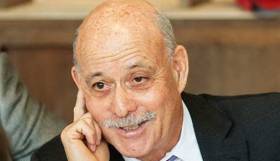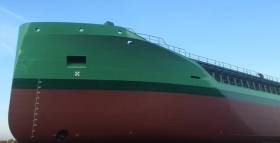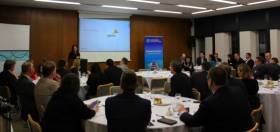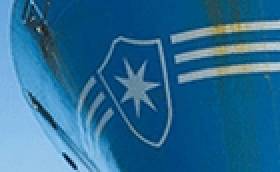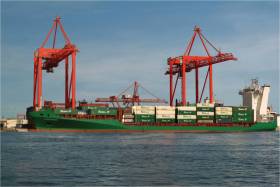Displaying items by tag: Port and Shipping News
#TopUSeconomist - American top-economist and influential thinker Jeremy Rifkin will give a key note address at the European Sea Port Organisation (ESPO) annual conference which is to be held for the first time in Dublin on 3 June.
Besides being the author of The Zero Marginal Cost Society: The Internet of Things, the Collaborative Commons, and the Eclipse of Capitalism and the best-selling author of nineteen other books on the impact of scientific and technological changes on the economy, the workforce, society, and the environment, Rifkin is advisor to the European Union and to heads of state around the world and is the president of the Foundation on Economic Trends in Washington.
“We are delighted to welcome Mr Rifkin at our conference. This year’s ESPO conference will seek an answer to the central question: Are European ports moving fast enough? With such a conference theme, we are extremely lucky to have Mr Rifkin amongst us in Dublin, setting out his vision. It is without saying an additional reason to attend this 13th edition of the ESPO conference”, says ESPO Secretary General, Isabelle Ryckbost.
The 2016 ESPO Conference will look into ways to improve the efficiency of maritime transport and ports, this from different angles: How to remove the remaining barriers in maritime transport and how to come to a real internal market for maritime transport? How to set the digital agenda for ports? Big data: what is in for European ports? How can ports benefit from new trade agreements? Could Schengen and Brexit be potential game stoppers?
Largest ConRo Sails As ACL Sign North American-Europe Deal
#GiantCONRO - Atlantic Container Lines (ACL) giant new 81,600 tonnes leadship Atlantic Star, the largest ever container/ro-ro (conro) built ship was noted by Afloat.ie off Anglesey yesterday while bound to Liverpool.
The Atlantic Star will operate alongside her sisters of the next generation G4 vessels on ACL's twice weekly calls at Halifax, Canada which are to be maintained by the operator in a deal running through to 2022.
The contract will see ACL continue to serve the North American and European markets at the Fairview Cove Container Terminal of Ceres Halifax Inc up to 2022. It was at this terminal at the Port of Halifax that welcomed the maiden call in January of the Chinese built giant Altantic Star which is almost 300m long.
Atlantic Star will be joined by four sisterships to form the new G4 ConRo vessels and are the largest of their type to be built incorporating innovative design features.
Compared to the G3 predecessors (see, Atlantic Companion stories from last year) the newbuilds container capacity is more than doubled at 3800 TEUs, plus 28,900 square meters of RORO space and a car capacity of 1300+ vehicles.
Andrew Abbott, President & CEO of ACL, "We value our long-term working relationships with the Halifax Port Authority and Ceres. We looked long and hard at various schedule alternatives for our new ships. Some excluded Halifax. But we just could not ignore the close cooperation and support of the HPA and Ceres that removed every obstacle to a long-term agreement. The quality improvements to the CN Rail service and the consistent cooperation of our ILA colleagues were also influential factors in our decision”
Abbot added “As a result of this, all the stakeholders of the port will benefit, as ACL volume via Halifax will eventually double as all of our new ships enter service. ACL looks forward to a long future in Halifax with our large, new, fuel efficient and environmentally friendly G4 vessels. The Port of Halifax will now remain our largest port in North America, and our gateway for Canada and the US Midwest."
ACL has been continuously calling the Port of Halifax since 1970 following the inaugural call of the ACL G1 vessel Atlantic Star in 1969 which flew the UK flag. With the recent introduction of Atlantic Star she too will be registered in the United Kingdom.
ACL's current schedule and port rotation will be maintained until all five G4 vessels are in service. During the second quarter of 2016 ACL will announce its new G4 schedule.
Another Arklow ‘Eco-Trader’ But Bow Design Differs to Sisters
#DifferentBow - The bow foreship of Royal Bodewes newbuild (yard No.723) to be named Arklow Valiant, was last week transported from the contruction hall to the outfitting quay at the Dutch shipyard, writes Jehan Ashmore.
The foreship was joined to the newbuild’s stern section complete with superstructure. What is notably different is the bow design compared to her sisters built to the yard’s ‘Eco-Trader’ 5,100dwt design series.
Leadship, Arklow Vale (yard No. 721) see first call to Dublin Port (and photo), features an energy effecient bow designed to save on fuel costs. Note the straight stem to reduce wave contact and upper sloping hull plating that faces astern (back towards the bridge).
To also compare the differences, watch the above video (below) of the newbuilld with a slightly raked bow yet remains more conventional when contrasted to launch footage of Arklow Vale last September.
The latest completed sister Arklow View (yard No. 722) carried out sea trials last month.
At almost 87m in hull length overall, the single-hold cargoships are to serve Arklow Shipping through Dutch division Arklow Shipping Nederland B.V. The pair are registered at Rotterdam.
A service speed of around 12.5 knots is generated by a main engine (MaK 6M25 1740 kW) with a Siemens Gearbox. As for the controllable pitch propellers they are manufactured by Berg.
EU Parliament Vote Brings Ports A Step Closer to Autonomy
#EUportRegulation - The European Parliament voted on the Port Regulation and the Fleckenstein Report yesterday.
The Parliament confirmed the outcome of the Transport committee. 451 MEPs voted in favour of the deal reached by the rapporteur and the shadow rapporteurs and 234 MEPs voted against, while 18 MEPs abstained.
An even larger majority voted in favour of giving the rapporteur the mandate to start negotiations with the council in view of reaching a first reading agreement.
The European Sea Ports Organisation (ESPO) welcomed the outcome of the vote in the Parliament as a solid basis for starting the negotiations with the Council. Commenting on the vote, ESPO Secretary General Isabelle Ryckhost said “With this vote, Parliament has given a strong signal in favour of an organisation of port services that takes into account the diversity of ports in Europe, in favour of more transparency and in favour of more autonomy for the European ports to set their charges"
"To play their role as gateways to the world and to face the various global economic, political and environmental challenges, port authorities need certain tools that allow them to pursue a proper strategy. We really hope that these principles will not be watered down in the further negotiation process with the Council”.
At the same time, ESPO expresses the wish that Parliament will be able to support the more pragmatic approach taken by the Council when it comes to the relations with port users and stakeholders and the establishment of a good and efficient framework for the handling of complaints.
#RailBoost - DFDS the Danish logistics and shipping operator, has announced from this month a doubling of capacity on its weekly intermodal rail service between the Port of Waterford and Ballina, Co. Mayo.
The new capacity according to Multimodal News, will benefit DFDS customers in the west and north-west of Ireland in particular, as a cost effective alternative when compared to a road based shipping option. Coupled with this, the customer also reduces their carbon footprint.
Train timetables are to meet DFDS sailing schedules from Port of Waterford (Belview Terminal) to Rotterdam, which allows for onward delivery into Europe.
Customers can now load in the west of Ireland on Tuesday morning and deliver in Holland on Friday. Rotterdam also provides access to DFDS sailings to Norway, and rail connections to Italy and Turkey, allowing for a rail-sea-rail connection from Ballina to Milan and Istanbul.
Importers into Ireland will also benefit from this extra capacity, with the rail solution particularly suitable for bulk tank operators and also shippers of large volume to the west and north of Ireland.
With this important service addition, DFDS claim they are now the only truly multimodal operator on the island. Furthermore, DFDS are working with Irish Rail to develop its rail capacity by offering longer trains as trails of such operations are currently in progress.
ICG Release Preliminary Statement of Results for 2015
#ICGresults- Irish Continental Group plc released today their Preliminary Statement of Results for Year Ended 31 December 2015.
Commenting on the results, Chairman John B McGuckian said, “2015 was another successful year for the group with growth in revenue of 10.5% to €320.6 million and earnings before non-trading items, interest, tax, depreciation and amortisation (EBITDA) of €75.5 million, up 49.5%. During 2015 the Group benefited from lower world fuel prices, stronger Sterling and increased carryings. The Group maintains a pivotal position in facilitating Ireland’s international trade and tourism and is operationally geared to the economic recovery in Ireland. We have seen the benefits of this recovery continue into the early weeks of 2016 which, notwithstanding a weakening in Sterling and assuming current oil prices, gives us confidence that we can look forward in 2016, in the absence of unforeseen developments to further growth in revenue and earnings.”
2015 Overview (see below, attached downloadable preliminary results and charts).
2015 has been another successful year for the Group, with a positive operational and financial performance in both divisions building upon the continued Irish economic recovery.
The Group has again strengthened its strategic position as the leading maritime transport provider in the Republic of Ireland. Revenue for the year grew by 10.5% to €320.6 million. EBITDA for the year increased by 49.5% to €75.5 million. Adjusted EPS, which excludes non-trading items, and the net interest cost on defined benefit pension obligations, was 87.7% higher at 29.1 cent. The Group’s return on average capital employed (ROACE) also increased significantly to 36.7% in 2015 (2014: 20.5%). The Group has benefited from the improvement in 2015 of the economies in our sphere of operations and the decline in global fuel prices. Sterling strength was a positive for tourism business in Irish Ferries. The strength of Sterling increased average yields during the period and also increased the attractiveness of Ireland as a tourist destination for UK based travellers. However, this benefit is partially offset by Sterling denominated costs. The Group’s total fuel cost was 26.4% lower than the previous year at €39.0 million (2014: €53.0 million). The benefit of lower fuel costs for the Group has been partially offset by a strong dollar versus the Euro, the fuel adjustment mechanism with freight customers where we pass on the reduction in fuel costs and the amendment of EU environmental regulations requiring the Group to consume more expensive fuel grades. The Group invested in its operations in the period through the acquisition of four LoLo container vessels adding to its owned vessel fleet and expansion of its container terminal operations at Belfast Port, both being examples of the continued growth in our operations.
BUSINESS REVIEWS Irish Continental Group operates through two divisions; the Ferries division operating under the Irish Ferries brand offering passenger and RoRo freight services. This division also carries out ship chartering activities. The Container and Terminal division, which includes the container shipping line, Eucon, and two container terminals, Dublin Ferryport Terminals (DFT) and Belfast Container Terminal (BCT), within the two main ports on the island of Ireland.
FERRIES DIVISION Revenue in the division was 10.6% higher than the previous year at €203.9 million (2014: €184.3 million). Revenue in the first half of the year increased 11.3% to €86.5 million (2014: €77.7 million), while in the second half revenue increased 10.1%, to €117.4 million (2014: €106.6 million). EBITDA increased to €63.7 million (2014: €43.1 million) while EBIT was €48.1 million compared with €28.0 million in 2014. The increase in profit was primarily driven by increased freight and passenger revenue and lower fuel prices in the year compared with 2014.
Car and Passenger markets It is estimated that the overall car market, to and from the Republic of Ireland, grew by approximately 1.2% in 2015 to 789,000 cars, while the all-island market, i.e. including routes into Northern Ireland, is estimated to have remained flat. Irish Ferries’ car carryings performed strongly during the year, at 400,900 cars, (2014: 381,800), up 5.0% on the previous year. In the first half Irish Ferries grew its car volumes by 7.1% while in the second half, which includes the busy summer holiday season at 3.6%.
The total sea passenger market (i.e. comprising car, coach and foot passengers) to and from the Republic of Ireland remained flat in 2015, at a total of 3.2 million passengers, while the all-island market decreased by 2%. Irish Ferries’ passenger numbers carried were up 2.0% at 1.676 million (2014: 1.643 million). In the first half of the year, Irish Ferries passenger volumes were up by 2.6% and in the second half of the year, the growth in passenger numbers was 1.5%.
RoRo Freight The RoRo freight market between the Republic of Ireland, and the U.K. and France, continued to grow in 2015 on the back of the Irish economic recovery, with the total number of trucks and trailers up circa 6% to approximately 888,000 units. On an all-island basis, the market was up around 4% to approximately 1.66 million units. Irish Ferries’ carryings, at 272,500 freight units (2014: 247,900), were up 9.9% in the year reflecting a strong performance by Irish Ferries relative to the market (volumes were up 11.5% in the first half and 8.5% in the second half). The freight market enjoyed excellent growth in 2015 helped by favourable economic condition in the Republic of Ireland. These economic factors in addition to the introduction of the ‘Epsilon’ in 2013 with the increased frequency it has provided has allowed us to outperform the market. The Epsilon in its second full year of operation has continued to perform well on both the Ireland – UK and Ireland – France routes.
Chartering The ’Kaitaki’ remained on its 4 year charter to KiwiRail during the year, operating in New Zealand. In an extension of the division’s chartering activities, four LoLo container vessels were purchased in late 2015 for a combined cost of €24.2 million. The vessels are the MV Elbfeeder (built 2008), MV Elbtrader (built 2008) and MV Elbcarrier (built 2007), each which has a capacity of 980 teu (Twenty Foot Equivalent) and a gross tonnage of 8,246 tons together with the MV Ranger (built 2005) which has a capacity for 803 teu and a gross tonnage of 7,852 tons. The three Elb vessels are currently on year-long charters to the Group’s container shipping subsidiary Eucon on routes between Ireland and the Continent whilst the Ranger is on charter to a third party.
CONTAINER AND TERMINAL DIVISION Revenue in the division increased to €118.2 million (2014: €107.0 million). The revenue is derived from container handling and related ancillary revenues at our terminals and in Eucon from a mix of domestic door-to-door, quay-to-quay and feeder services with 71% (2014: 71%) of shipping revenue generated from imports into Ireland. With a flexible chartered fleet and slot charter arrangements Eucon was able to adjust capacity and thereby continue to meet the requirements of customers in a cost effective and efficient manner. EBITDA in the division increased to €11.8 million (2014: €7.4 million) while EBIT rose 93.6% to €9.1 million (2014: €4.7 million) due mainly to increased volumes both in Eucon and in our terminal operations as well as reduced fuel costs. Overall container volumes shipped were up 3.4% compared with the previous year at 286,500 teu (2014: 277,200 teu).
Containers handled at the Group’s terminals in Dublin Ferryport Terminals (DFT) and Belfast Container Terminal (BCT) were up 32.9% at 248,500 lifts (2014: 187,000 lifts). DFT’s volumes were up 6.6%, while BCT’s lifts were up 146.4%. The increase in Belfast arises from the awarding in April 2015 by Belfast Harbour Commissioners (BHC) of the Services Concession to BCT for the operation of a combined container terminal at Victoria Terminal 3 (VT3). The process of combining the two existing container terminals in Belfast began in June and was completed in September.
On 1 January 2015, the EU Sulphur Directive came into force in many parts of Northern Europe, including the North Sea and the English Channel termed as Sulphur Emission Control Area’s (SECA’s). This reduced the permissible level of sulphur in bunker fuel from 1.0% to 0.1% for vessels in these SECA’s requiring the vessels in the Eucon fleet to consume higher cost, low sulphur fuel.
FINANCE EBITDA for the year was €75.5 million (2014: €50.5 million). There was a net outflow of working capital of €1.6 million, due to the higher level of activity in our operations. The Group made payments, in excess of service costs, to the Group’s pension funds of €2.7 million. Cash generated from operations amounted to €71.8 million (2014: €44.4 million).
Interest paid was €2.8 million (2014: €3.6 million) while taxation paid was €0.8 million (2014: €1.1 million). Interest received amounted to €0.1 million (2014: €0.1 million).
Capital expenditure was €35.0 million (2014: €8.0 million) which principally included €24.2 million for the acquisition of container vessels together with the annual refits of the passenger vessels.
The Group’s IAS 19 year end pension deficits were €5.1 million (2014: €24.1 million). Net debt at year end was €44.3 million (2014: €61.3 million) which represents 0.6 times EBITDA (2014: 1.2 times EBITDA). DIVIDEND During the year the Group paid the final dividend for 2014 of 7.035 cent per ICG Unit. The Group also paid an interim dividend for 2015 of 3.638 cent per ICG Unit, and the Board is proposing a final dividend of 7.387 cent per ICG Unit, payable in June 2016, making a total dividend for 2015 of 11.025 cent per ICG Unit, an increase of 5.0% on the prior year.
Subject to shareholder approval at the Annual General Meeting, the final dividend will be paid on 10 June 2016 to shareholders on the register at close of business on 27 May 2016. Irish dividend withholding tax will be deducted where appropriate. THE BOARD In the first half of the year executive directors Tony Kelly and Garry O’Dea retired from the Board on reaching the normal retirement age of 60 years. On 3 March 2016, the Group appointed David Ledwidge as a Director of the Company. David joined ICG in 2006 and in February 2015 was appointed as Chief Financial Officer ("CFO") designate taking up the CFO role in June 2015. He has been with ICG for over 9 years and has played a very significant part in the development of the Company which now looks forward to his contribution at Board level.
CURRENT TRADING & OUTLOOK Since our last update to the market, in the Interim Management Statement of November 2015, trading conditions have remained favourable. Revenue for the year increased by 10.5% for the full year, versus 9.9% for the 9 months to the end of September 2015 resulting in EBITDA for the final quarter of 2015 up €3.1 million at €11.4 million. The improved momentum has continued into the first two months of 2016. In the period to date cars are up 4% on last year and passenger carryings are 1% ahead of 2015. RoRo freight volumes are up 14% on the same period in 2015. In the Container and Terminal Division containers carried are up 12% while port lifts reflecting the expanded operations at Belfast Port are up 53% year to date.
Lower world fuel prices will continue to help performance although the recent weakening of Sterling will affect the Euro value of UK originating revenues. As a result of these factors, and the ongoing improvement in the economic outlook in our sphere of operations, we look forward, in the absence of unforeseen circumstances, to further growth in revenue and earnings for the financial year 2016.
Shipping Review: Eco-Trader's First Sea Trials, Inaugural Shipping Forum & First Also for Maersk
#ShippingReview – Jehan Ashmore reviews the shipping scene over the last fortnight.
Eco-Trader, Arklow View took her first sea trials for Arklow Shipping’s Dutch division when the cargsoship newbuild took to open waters off Eemshaven.
Another first took place back in Ireland, as the Irish Maritime Development Office (IMDO) hosted the Ship Commerce Forum, the event entitled ‘Maritime Finance: Opportunities for Ireland’.
Dublin Port Company’s opposition to plans for housing on Poolbeg peninsula, raised fundamental issues of whether this area is suitable for residential-led regeneration.
Another port with infrastructure plans, the Port of Cork is set to gain €30m from the European Investment Bank (EIB) to development the country's biggest natural harbour.
Quinn Cement to build new cement silos at Warrenpoint Harbour in a £2.5 million investment. The silos 7,500 tonnes capacity will be used to export the product.
Irish Continental Group (ICG) appoints David Ledwidge as a Director of the Company, having previously held position of Chief Financial Officer designate.
Maersk Group is to return to the Port of Liverpool through subsidiary Seago Line. In addition the line is make direct calls to Dublin Port, a first ever for the Maersk group on the Europe 'feeder-service' to North African and Mediterranean ports.
#MaerskDublin - Danish container giant, Maersk is set to return to the Port of Liverpool writes Lloyds Loading List, after more than a decade hiatus through its intra-European shortsea subsidiary Seago Line.
From April, feeder specialist Seago Line will provide a direct service between the British Isles and Spanish transhipment hub Algeciras, where customers will be connected to markets in North Africa and the Mediterranean.
The new Seago service will also call at the port of Dublin, representing the Maersk Group’s first ever direct call in the Irish capital. This will supplement the existing Latin American service to Cork operated by sister carrier Maersk Line and provide shippers with an alternative from the current feeder option from Rotterdam in Europe’s northern range.
In a joint statement, Maersk Line and Seago said the new service will allow for “easier access to other trades and helps sister companies Maersk Line and Safmarine deliver for their customers in the North West of England and Ireland”.
For more on the group's return to Merseyside and operations to Dublin Port next month, click here.
#Director - Irish Continental Group (ICG) parent company of Irish Ferries, yesterday announced the appointment of David Ledwidge as a Director of the Company.
Ledwidge joined the shipping (incl Lo-Lo), transport and leisure group in 2006. In February 2015 he was appointed as Chief Financial Officer designate taking up the CFO role in June 2015.
ICG chairman John B.McGuckian commenting on the board appointment said "The Board is delighted to announce the appointment of David Ledwidge as a Director of the Company. He has been with ICG for over 9 years and has played a very significant part in the development of the Company. We now look forward to David's contribution at Board level".
In 2006 Ledwidge joined the group from Professional Services firm Deloitte. He is a member of the Institute of Chartered Accountants in Ireland and is a Bachelor of Science Graduate from Dublin Institute of Technology.
It Pays to Install Green Technology – DFDS Director
#GreenTechology - At the annual European Marine Engineering Conference next month the event will climax with The Doug Woodyard Memorial Debate.
Poul Woodall, director, environment and sustainability, DFDS will be speaking against the motion: This conference believes it does not pay to install green technologies.
Danish ferry operator DFDS (including Dover-Calais) is the world champion in marine scrubbers, believes its director for sustainability and development Poul Woodall.
To read more, Passenger Ship Technology has more here.
Afloat adds that DFDS have recently added Côte Des Flandres the second of a pair of former MyFerryLink ferries (sold by Eurotunnel) onto the Dover-Calais route last month. The refurbished 1,500 passenger/400 car capacity ferry complete with new livery, joins Côte des Dunes, which too entered service last month following a similar refit.
The additional capacity brings to three DFDS ferries, the Calais Seaways which had been accompanied by Malo Seaways. The former Irish Sea ferry Stena Nordica was replaced almost year ago by Dublin-Holyhead newcomer Stena Superfast X. She was on charter from Stena to DFDS serving the route as the Dieppe Seaways.


























